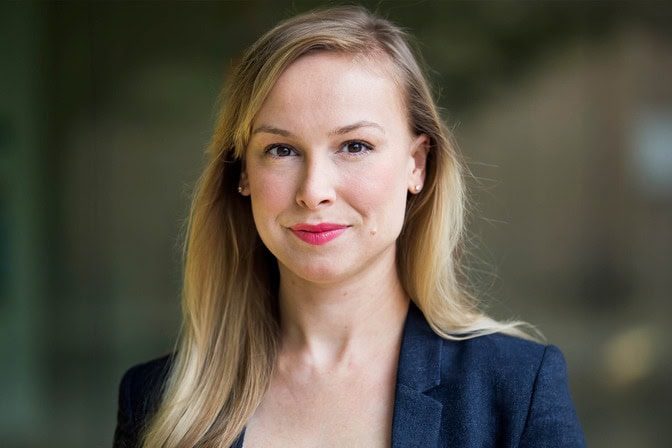
A new era in AI health research: A Q&A with Jenna Wiens
A co-director of U-M’s AI & Digital Health Innovation discusses the custom-built digital environment that will power tomorrow’s health AI research.

A co-director of U-M’s AI & Digital Health Innovation discusses the custom-built digital environment that will power tomorrow’s health AI research.
Experts
AI and machine learning are transforming health care, helping clinicians to spot potential issues earlier, make more informed decisions and have more meaningful interactions with patients. And Jenna Wiens, an associate professor of computer science and engineering, has spent the past decade building the infrastructure for that transformation as a key member of the University’s Precision Health Initiative. That initiative was re-launched as the AI & Digital Health Innovation center (AI&DHI) in March of 2025, reflecting its pivot from building research infrastructure to conducting digital health research.
Among AI&DHI’s resources is a HIPAA-aligned computing environment that offers researchers access to a data repository with de-identified information on more than 5 million patients, as well as an extensive genomics dataset. In addition, the center offers research implementation services and the opportunity to collaborate with more than 400 experts from 75 U-M departments across 17 schools and colleges.
Wiens has also been a driving force behind e-HAIL, a joint College of Engineering and Michigan Medicine initiative that brings researchers together to move new AI research forward. e-HAIL supports researchers in preparing grant applications, finding collaborators, writing grants and hiring student support for generating preliminary data.
We sat down with Wiens in early 2025 to talk about the process of building AI&DHI and e-HAIL, and to talk about the role they will play in continuing Michigan Engineering’s legacy of leadership in digital health research.
Absolutely. AI tools and models have been a part of healthcare for years now, but our previous research has shown that they don’t always live up to their potential in real-world situations. We want to take them to the next level by closing the gap between technology and on-the-ground clinical situations. And I think our collaborative atmosphere and tools put us in a great position to do that.
We’re also looking at how to use AI to improve interactions with patients, by having it handle some of the more tedious things like transcription and summarization. So that your doctor can be more engaged with you and less burdened by the nuts and bolts of gathering information.
It’s about improving lives, and that means more than just improved outcomes. We want healthcare to become more people-centric, and I think AI has a key role to play.
AI&DHI’s name is new, but it actually grew out of U-M Precision Health, which brought faculty from across campus together in 2017 to build out a digital health infrastructure. And we built what I think is a uniquely comprehensive and accessible system. We worked closely with Michigan Medicine, the world-class hospital down the street. But unlike a lot of other digital health research systems, ours is not confined within the hospital. Whether you’re on the hospital side or a computer scientist like me, there’s a clear process for gaining access to a secure, HIPAA-aligned computing environment.
With all that in place, we now have a greatly expanded breadth of services in AI, in digital health, in genomics, and the new name does a much better job of reflecting that. We’ve built this foundational infrastructure that can enable research, and I’m very excited to be entering the next stage, which is doing that research.
We also offer researchers a strong support community in e-HAIL.
I did co-found e-HAIL, yes. There was a time back in 2020 where we realized there was so much interest in and demand for AI in the health research space, and we needed to be facilitating conversations to move that research forward.
e-HAIL counts about 100 researchers total, and the core of it is pretty simple—every two weeks, a group of around 20 researchers gets together to talk about research ideas, typically grant proposals.
The key is that it’s very collaborative across healthcare and engineering. So you can share your idea and get feedback in real time from cardiologists, intensive care experts, computer vision experts and so many others. And I’ve found that explaining an idea to all those different groups is a really powerful learning experience that makes your proposals a lot stronger and more likely to get funded.
There really aren’t a lot of boundaries, and that’s one of the best things about my job.
As an engineer working with Michigan Medicine, I’m co-leading the team, and that’s pretty unique. I’m not just a programmer supporting someone else’s idea. They’re as interested in helping me advance AI as I am in helping them advance health.
I’ll give you an example: AI&DHI isn’t housed within Michigan Medicine, it’s set up to be a truly equal collaboration with one co-director from Michigan Medicine, one from the School of Public Health and one from the College of Engineering.
And that spirit of collaboration extends to other parts of the university as well. U-M is huge and there are so many resources in computer science, health, law, business. But because it’s such a collegial place, somehow it feels smaller than it actually is.